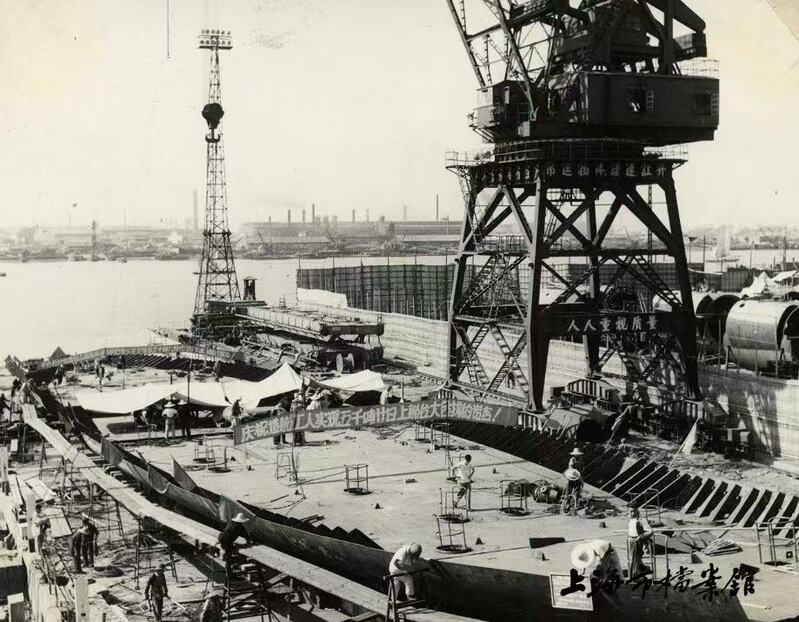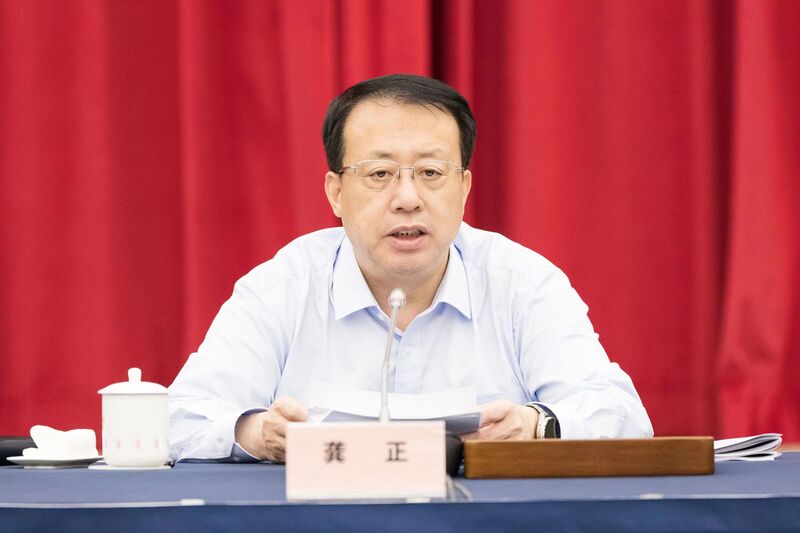After the Liberation, Mayor Chen Yi's Demands Must be Solved | Looking Back at Shanghai Research, Ordinary People Have No Houses, Live Squeezed, Live Far in Beds | Employees | After the Liberation
Editor's note: Correct decision-making cannot be achieved without investigation and research. Our party has always attached great importance to investigation and research, insisting on making decisions based on grasping the truth. On the occasion of the nationwide investigation and research, the Liberation Daily Shangguan News collaborated with the Shanghai Municipal Archives Bureau and others to launch a "Looking Back at Shanghai Research" column, introducing important research related to Shanghai's economic and social development since 1949, to entertain readers.
"Some workers can only have one bed in their houses, and after work, the whole family squats on the bed." "Some grandparents and grandchildren live in the same room, and their 18-19 year old children still sleep on the same bed." In the archives of the Shanghai Archives, a survey report by the Shanghai Federation of Trade Unions in 1956 on the issue of employee housing intuitively reflects the housing difficulties of Shanghai citizens at that time.
Before the liberation, Shanghai faced a serious housing shortage problem, and the housing conditions of the working class were particularly difficult. After the liberation, the Shanghai Municipal Party Committee and Government attached great importance to the housing issues of the general public. In April 1951, Chen Yi, the then mayor of Shanghai, delivered a report on the "Work Tasks of Shanghai in 1951" at the Second People's Congress of the city, clearly stating that "municipal construction must serve the development of production. Therefore, the policy of municipal construction is to first serve the working class.". The specific requirements are focused on repairing and constructing worker housing, constructing roads and bridges in the factory area, improving sewage, drinking water supply and environmental sanitation, and improving the conditions of factories and worker residential areas.

In the following decade, after multiple rounds of investigation and research, Shanghai organized and implemented measures such as new housing construction, "self built public assistance", "two adjustments", and tapping into the potential of housing, which played an important role in improving the living conditions of employees.
On April 11, 1951, Chen Yi gave a work report at the Second People's Congress of All walks of life in Shanghai
Fewer houses, crowded living, long roads

To conduct investigation and research, the first step is to delve into reality and understand the situation. In the 1950s and 1960s, various departments and units in Shanghai conducted extensive research on housing issues. In 1956, the Municipal Federation of Trade Unions conducted a survey among over 110000 employees in 144 state-owned and old joint venture factories, and found that housing difficulties were mainly manifested in several aspects such as "limited housing", "crowded living", and "long roads". Regarding this, the investigation report provides detailed records:
In 1956, the Municipal Federation of Trade Unions issued the "Issues and Improvement Opinions on the Housing and Transportation of Shanghai Workers"
According to a survey conducted by the Municipal Housing Management Bureau on the residential areas of some employees, about 44% of them have an average living area of less than 2 square meters per person. Some employees are living in extremely crowded areas, with many workshop stoves, bathrooms, and sunroofs filled with people. The rooms are separated one after another, and the second floor is converted into a four story pavilion;
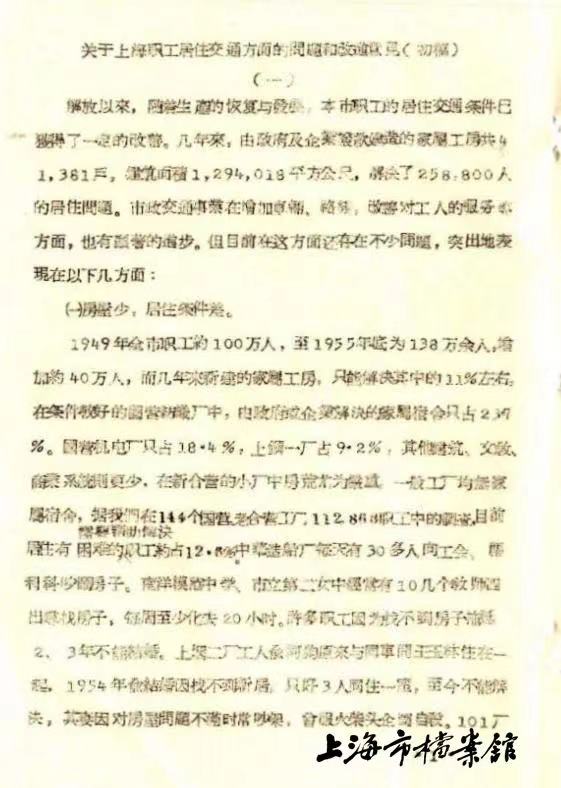
A female worker from the 19th National Cotton Factory, living in the same room with eight people, shared a bed with her 19-year-old son. In his dream, his son kicked her under the bed and her injury has not healed yet;
Many workers used to live in such shacks
"Many workshops are dark and humid, with poor air quality. Workers complain that they are 'stuffy, hot, and smelly', and that there is no light on all sides. In winter, it freezes and there is no ventilation on hot days. On hot days, the whole family sleeps on the road.";
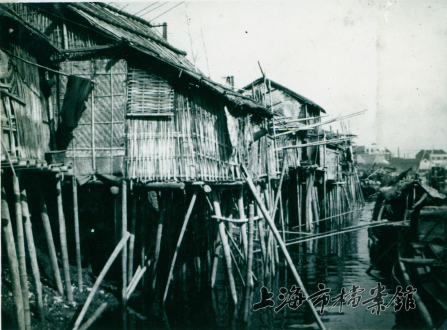
There are still various chaotic and unreasonable phenomena in the burden of living expenses, such as inconsistent rent standards, often resulting in significant rent disparities between houses of the same size and quality, between public and private houses, and between private and private houses
In addition, houses also face the risk of leakage. According to survey statistics, 11.7% of employees live in grass huts, 27.9% live in simple houses, and 50% live in old houses. Among them, 61.6% are in a dangerous state, with many workshops experiencing heavy rain outside and light rain inside. Many buildings have already exceeded their warranty period, and even larger rooms and floors shake up and down. Unfortunately, children often fall and die inside these buildings. There are many similar situations.
The simple houses by the stinky water ditch in Shanghai in the past. How to improve the living conditions of citizens is an important issue faced by the people's government in the early days of liberation
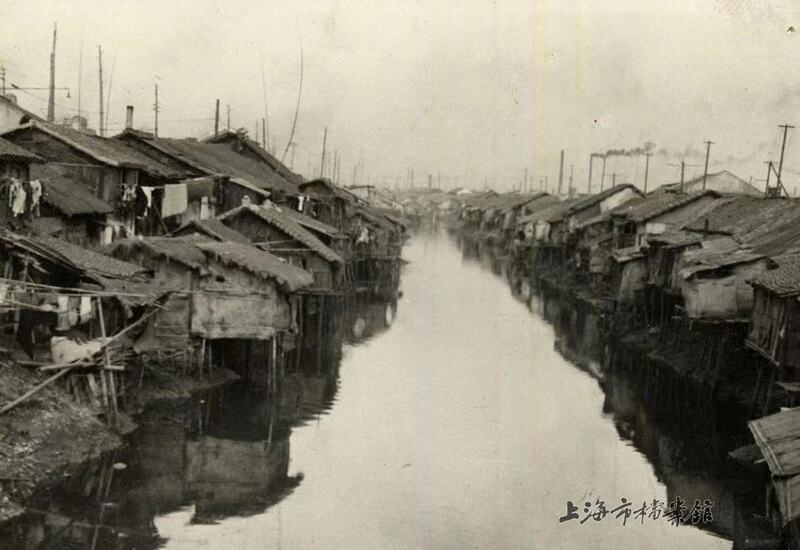
Targeted construction of worker housing
In order to solve the housing difficulties faced by citizens, the construction of new housing has been put on the agenda first. From 1950 to 1966, the municipal government and the Municipal People's Committee built a total of 8.9606 million square meters of new residential buildings. These houses are mainly supplied to workers.
Chen Yi once emphasized that due to financial difficulties, we should not "promote all kinds of waste and carry out comprehensive development", but rather focus on "key construction and general maintenance". This also clarifies that due to limited funds and resources, it is not possible to spend more time on the construction of worker housing projects throughout the city, and can only be carried out in a focused manner.
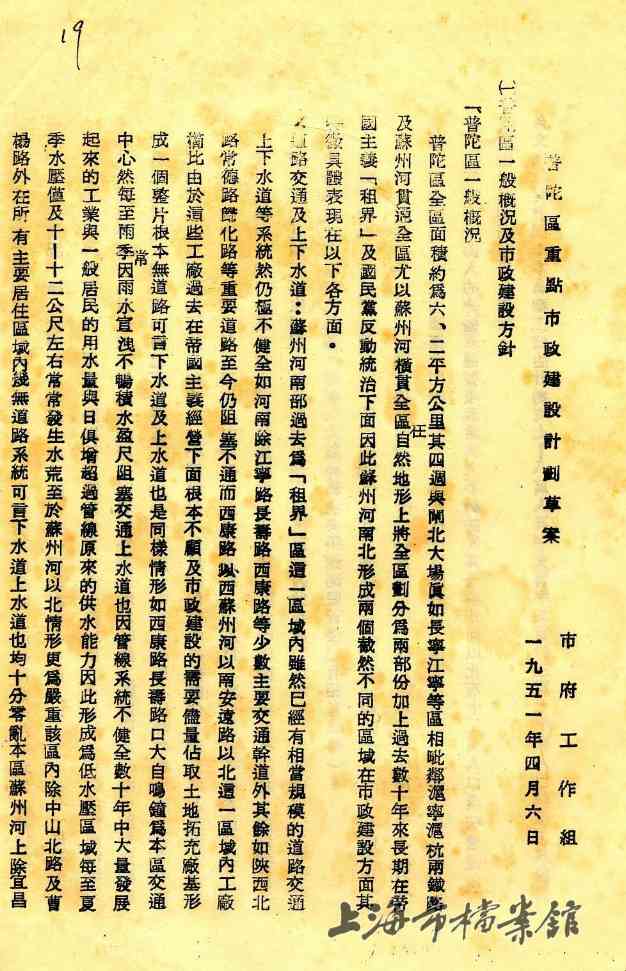
Draft Plan for Key Municipal Construction in Putuo District in April 1951
In this context, site selection work has become particularly important. In March 1951, the Organization Department of the Municipal Party Committee organized a working group to conduct on-site research in Putuo District, western Shanghai, and reported to the Municipal Party Committee and Government on the living conditions and surrounding environment of local workers. Subsequently, several groups of representatives were organized to conduct on-site inspections and research. After investigation and research, the Shanghai West region, where workers are concentrated and the living environment is poor, was ultimately selected as the first area to build a new worker village.
In 1952, the newly completed Caoyang New Village
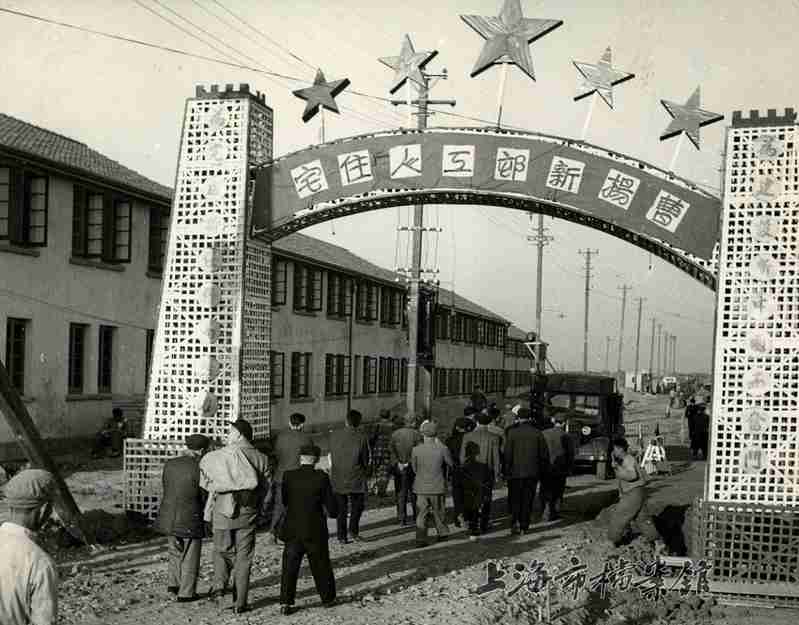
Caoyang New Village, known as the "first residential city for workers in New China," was born. The design of worker housing in Caoyang New Village is the specific responsibility of the Shanghai Urban Planning and Research Committee and the Public Housing Management Office. Regarding the construction standards for worker housing, experts have successively inspected the alleyway residences in Jinxiu Village, Tokyo Village, and Nanyinghua Village in Putuo District and Yangpu District, as well as 15 old workshops in several textile factories. They suggest that we not only improve the original level, but also ensure that factories and enterprises can follow the trend in building residences in the future. Based on the principles of simplicity, practicality, and necessary public facilities, the environment should be neat and clean. The design experts promptly proposed preliminary design models, and the municipal engineering bureau and other units invited worker representatives to have discussions, and finally determined the building style and equipment standards.
A worker's family moving into Caoyang New Village
In March 1951, the municipal government constructed the first batch of 1002 worker residences in the Caoyang area, which were completed in May 1952. In the same month, funds were allocated to build 20000 new workshops in Yangpu, Putuo, Changning and other areas. They were completed in September 1953 with a total construction area of 600000 square meters, solving the housing problem for approximately 100000 employees and their families. From 1953 to 1958, in addition to receiving funding from the municipal government for the construction of residential buildings, enterprises also contributed to the construction of 161 new residential villages, including Tianshan and Fengcheng.

After 1958, with the adjustment of Shanghai's industrial layout, the focus of residential construction shifted to suburban industrial areas and satellite cities. According to the principle of "facilitating employees to work on site, live nearby, and avoid long-distance travel", a large number of new residential villages have been built in Minhang, Wujing, Jiading, Anting, Songjiang, Jinshan, Baoshan, and other areas. By 1995, a total of 129 villages had been built, with a total construction area of over 10 million square meters. The construction of these new residential villages has alleviated the urban population and improved the overcrowding situation in the city.
In 1952, the on-site construction conference for "20000 households" of worker housing was held
"Self built public assistance" to alleviate housing shortage
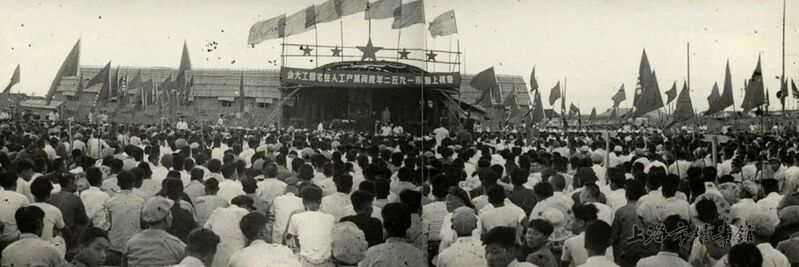
On July 23, 1956, the Liberation Daily published an article titled "Why is the Shanghai housing problem difficult to solve?". The article suggests that when allocating housing, each unit should take care of the people with the worst living conditions, and use methods such as loans and self built public assistance to help employees and cadres build their own houses. These are all worth considering.
The term "self built public assistance" here refers to a housing construction method in which employees with certain economic capabilities in enterprises voluntarily organize the construction of housing by their respective enterprises, and the government and enterprises provide certain assistance in land, loans, building materials, construction forces, municipal facilities, and other aspects according to possible conditions.
In 1952, the first self built public assistance new village in Shanghai - the relocation new village began to be planned. Initially, a group of movers established an autonomous committee. Later, the trade union organized them and adopted the method of "savings mutual assistance, trade union loans" to raise funds, laying the foundation for self construction and public assistance. The specific operation is to pay 200 yuan per household first, and the balance is divided into seven levels based on each household's weekly income: the highest level is for families with a weekly income of 30 yuan to repay 40%; The minimum level is for families with a weekly income of 10 yuan to repay 10%. The new village was completed on July 16, 1953, with a total of 62 two-story buildings built, solving the housing problems of over 100 workers.

In July 1958, the Municipal Construction Committee issued several principles on organizing employees to self build public assistance
In 1957, self built public assistance was widely promoted within various industry systems in Shanghai. In March, Shanghai released the "Interim Measures for Self built Public Assistance for Enterprise Employee Housing", which made detailed provisions on the application conditions, foundation, public facilities, loans, construction forces, and many other issues related to self built public assistance. At that time, a total of 4749 self built public housing units in the city had started construction and were ready to start construction, with 1837 completed, which played a positive role in solving the shortage of housing for employees.
Located on the east side of Shanghai Railway Station and the north bank of Suzhou. Before liberation, it used to be a gathering place for refugees. People used bamboo, straw, and yellow mud to build simple shantytowns, which were connected into patches and commonly known as "rolling earth dragons"
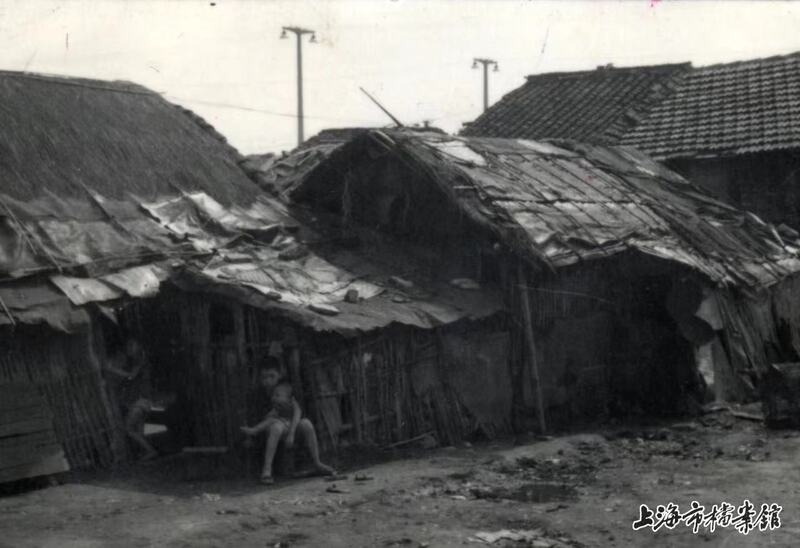
In the mid-1950s, in addition to self construction and public assistance, factories and enterprises also adopted various methods such as self funded renovation and national investment to actively help employees rebuild shantytowns. The renovation of shantytowns and dilapidated houses has placed an important position, gradually entering the stage of unified planning and large-scale renovation. The main approach at that time was to combine industrial, cultural and educational construction, and major municipal construction, demolish shantytowns and simple houses, relocate residents, and open up residential construction bases. The municipal government has invested in pilot projects for large-scale renovation in the Tanggua Lane, and has achieved successful experience. Within a few years, the total area of shantytowns renovated in the urban area reached about 2.2 million square meters, with a residential population of nearly 400000. The number of tiled houses increased from 13.9% to 77%, and the "rolling dragon" completely disappeared.
In the 1960s, Fangua Lane began to be transformed into the first five story worker's new village in Shanghai. The picture shows the residents of Fanggua Lane moving into their newly renovated homes. Now, a new round of renovation has begun in the Tanggua Lane
Carry out "two adjustments" according to the timing and local conditions
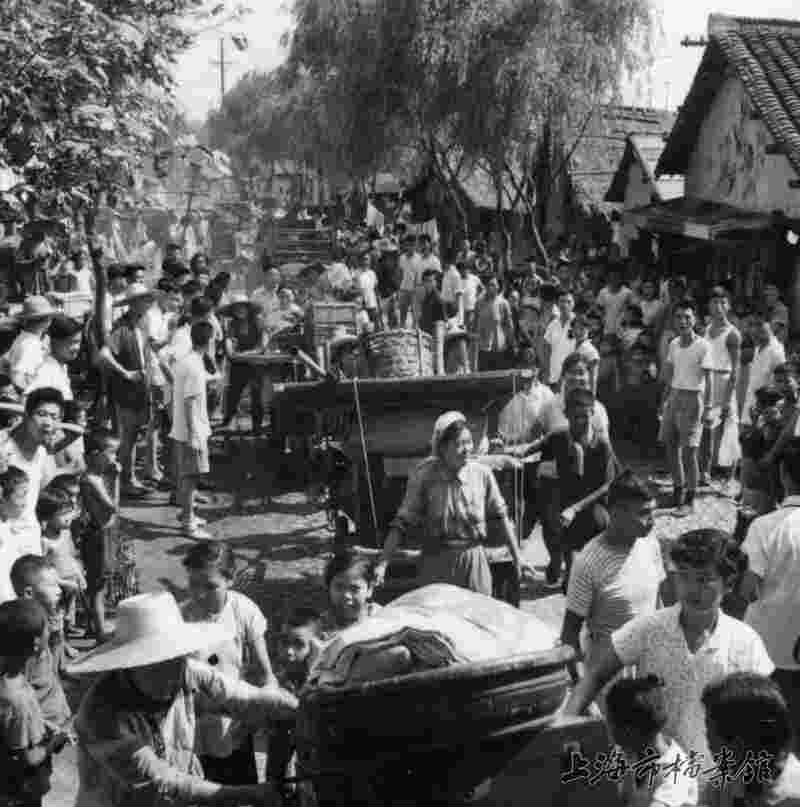
The long journey to work was also an important manifestation of the housing shortage problem in Shanghai at that time.
In the late 1950s, in several industrial areas such as Tilan and Yangpu, as well as in some production systems and large factories, nearly half of the employees did not live in this area, some as high as 80%, and even some workers scattered in suburban counties. Among the 1.98 million employees in the city, nearly 200000 lived far away from the 15th mile mark.
In the 1950s, a female worker from an instrument factory in Shanghai was assembling an electric meter

Therefore, many employees have to wake up before dawn every day, go out early in the morning, and go home late at night. Female workers have to take care of children at night and can only sleep four or five hours a day. For example, Tang Xiulan, a worker from the 16th National Cotton Factory, has a factory located in the west of Shanghai and a home in Pudong. It takes three to four hours to travel back and forth, and sometimes she cannot catch a ferry and is late. Due to spending a lot of time on the road, which seriously affects her rest, she often fails to complete her production plan. When the group gives her feedback, she lowers her head and cries... Some workers work night shifts or three shifts, and because there is no bus to work, tricycles are too expensive, so they have to walk in the middle of the night. Some sleep overnight next to the machines in the factory or on the iron drums and wooden boxes used for loading.
In this regard, the People's Daily believes that "this situation is detrimental to the production, rest, and leisure learning of employees... This requires the urban real estate department to organize housing exchange work. Various regions can adapt to local conditions and carry out housing exchange work in an organized and planned manner.".
In 1960, the Shanghai Municipal Party Committee decided that the Municipal Federation of Trade Unions would take the lead in carrying out the adjustment of employee work and the replacement of employee housing, with the aim of solving the problem of long-distance travel for employees by adjusting their work units or changing their housing locations. Subsequently, under the leadership of the Party Committee, each factory, based on the Human Resources Department and the Labor Wage Department, formed a "Two Adjustment" working group with a certain amount of strength drawn from relevant departments, and began various preparatory work. Starting from late April, the city's "two adjustments" work has been actively carried out. From April 1960 to December 1961, a total of 84985 Luyuan employees were adjusted, accounting for 40.4% of Luyuan employees, including 54620 transferred jobs and 30365 housing problems solved.

By the 1960s, the living conditions of Shanghai citizens had improved to a certain extent. The picture shows the newly built multi story residential building at that time
In the early 1960s, Shanghai also vigorously explored the potential of houses through investigation and investigation, and tightened and adjusted the existing houses, especially those with unreasonable use, to free up some vacant houses. These measures have achieved good results and to some extent improved the living conditions of employees. Although constrained by various factors, they have not been able to fundamentally solve the housing difficulties of urban workers, the preliminary investigation and research, as well as the later exploration and practice, have created conditions and possibilities for truly solving the housing problem after the reform and opening up.
The improvement of living conditions greatly inspires and motivates the enthusiasm of workers for work. The picture shows in August 1959, workers at Jiangnan Shipyard were working tirelessly to secure the early launch of a 5000 ton ocean liner
